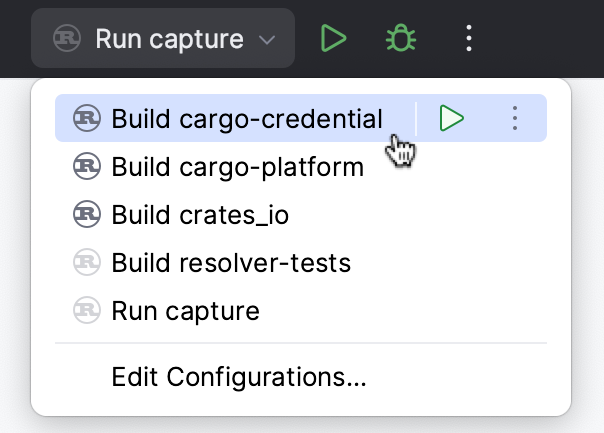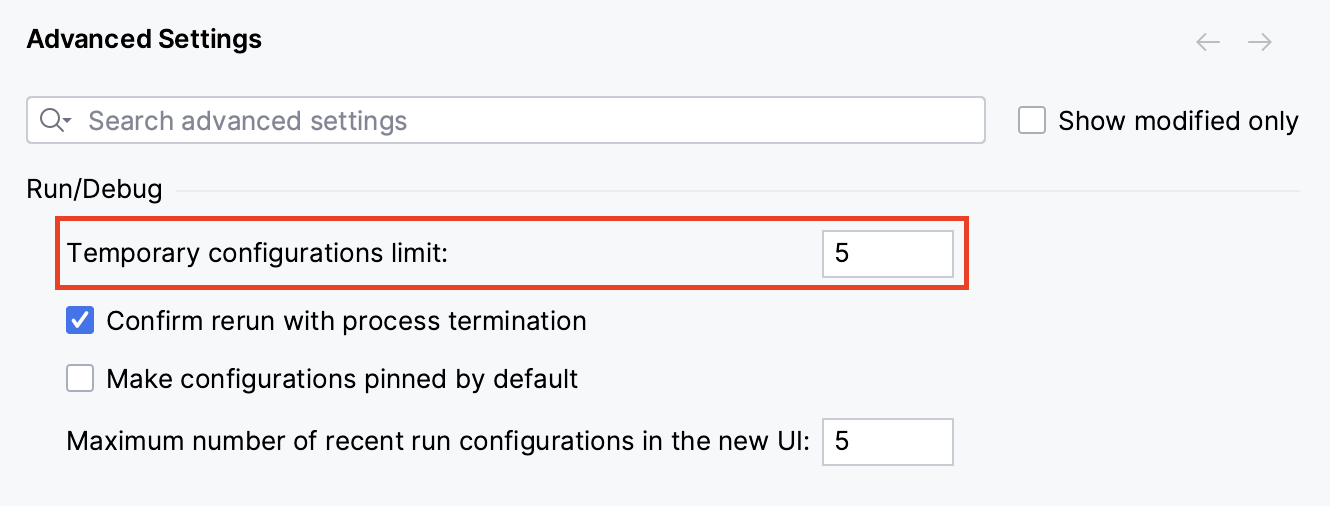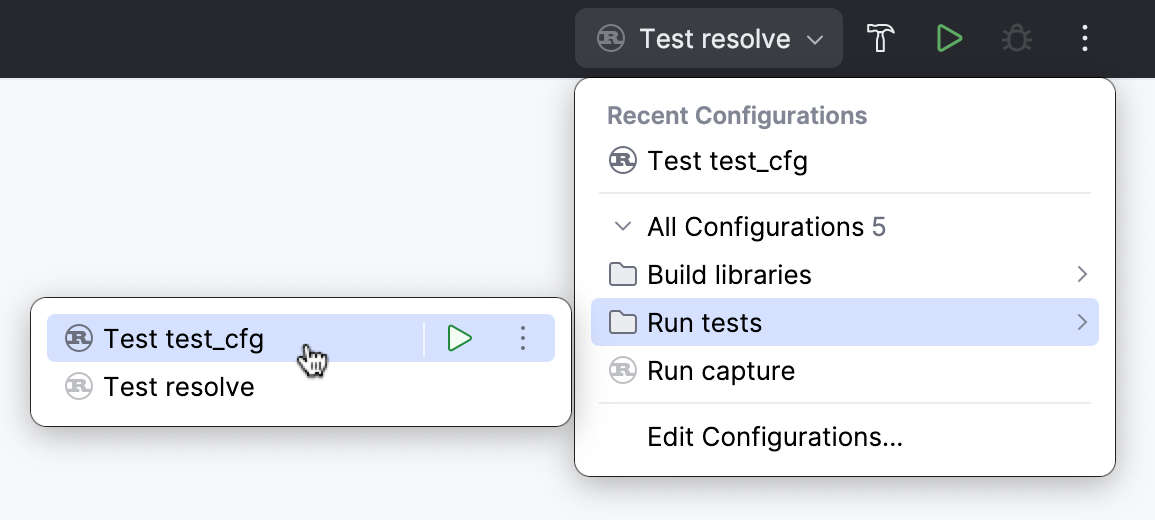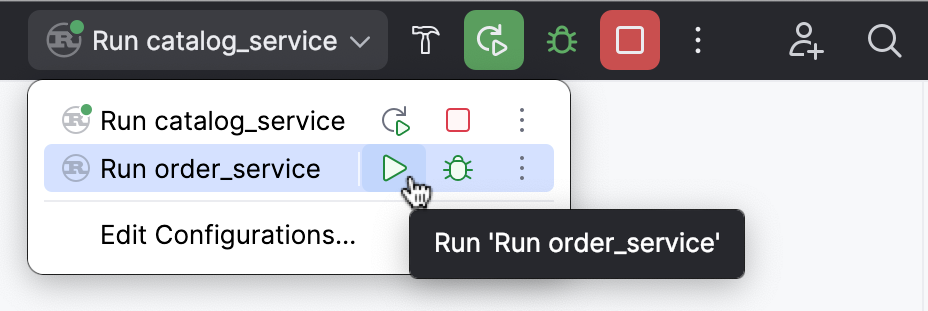Run/debug configurations
Create Cargo configuration: Run | Edit Configurations | | Cargo
Create wasm-pack configuration: Run | Edit Configurations | | wasm-pack
RustRover uses run/debug configurations to run, debug, and test your code. Each configuration is a named set of startup properties that define what to execute and what parameters and environment should be used.
There are two types of run/debug configurations:
Temporary — created every time you run or debug functions or tests.
Permanent — created explicitly from a template or by saving a temporary configuration. Permanent configurations remain as part of your project until you remove them.
Whenever you run, debug, or test your code, RustRover either uses an existing permanent run/debug configuration or creates a new temporary one.
Permanent configurations have opaque icons while the icons of temporary configurations are semi-transparent. The red cross over the configuration icon indicates an error in configuration settings.

The maximum number of temporary configurations is 5. The older ones are automatically deleted when new ones are added. If necessary, you can increase this limit in Settings | Advanced Settings | Run/Debug | Temporary configurations limit.

RustRover provides the following ways to create a permanent run/debug configuration:
Create from a template (for example, Cargo, wasm-pack) or copy an existing configuration.
In the run/debug configuration switcher, click
next to the name of the temporary configuration to save and select Save Configuration.

Open the Edit Configurations dialog (Run | Edit Configurations), select the temporary configuration to save, and click
on the toolbar.

RustRover provides run/debug configuration templates for different languages, tools, and frameworks. The list of available templates varies depending on the installed and enabled plugins.
In this area, you can specify tasks to be performed before starting the selected run/debug configuration. The tasks are performed in the order they appear in the list.
Item | Shortcut | Description |
|---|---|---|
Click this icon to add one of the following available tasks:
| ||
Click this icon to remove the selected task from the list. | ||
Click this icon to edit the selected task. Make the necessary changes in the dialog that opens. | ||
Click these icons to move the selected task one line up or down in the list. The tasks are performed in the order that they appear in the list. | ||
Show this page | Select this checkbox to show the run/debug configuration settings prior to actually starting the run/debug configuration. | |
Activate tool window | By default this checkbox is selected and the Run or the Debug tool window opens when you start the run/debug configuration. Otherwise, if the checkbox is cleared, the tool window is hidden. However, when the configuration is running, you can open the corresponding tool window for it yourself by pressing or . |
You might want to share your run/debug configurations so that your teammates could run the application using the same configuration or enable them to remotely attach to the process you are running.
RustRover provides a mechanism to store your run/debug configurations as project files and share them through VCS. The same mechanism can also be used when you want to send your configuration as a file to someone else, create a local backup of your run/debug configurations, or import them from a file.
Go to Run | Edit Configurations. Alternatively, press , then .
Select the run/debug configuration you want to share, enable the Store as project file option, and specify the location where the configuration file will be stored.

(Optional) If the .idea directory is added to VCS ignored files, the .idea/runConfigurations subfolder will be ignored, too. If the project uses Git, you can share .idea/runConfigurations and leave .idea ignored by modifying .gitignore as follows:
/.idea/* !/.idea/runConfigurations
note
Turning on the Store as project file option does not submit anything to the VCS. For run/debug configurations to make their way to a shared repository, you have to check them in like the other versioned files.
All run/debug configurations are based on templates, which implement the startup logic, define the list of parameters and their default values. The list of available templates is predefined in the installation and can only be extended via plugins. However, you can edit default parameter values in each template to facilitate the setup of new run/debug configurations.
Go to Run | Edit Configurations. Alternatively, press , then .
In the left-hand pane of the run/debug configuration dialog, click Edit configuration templates.
In the Run/Debug Configuration Templates dialog that opens, select a configuration type.
Specify the desired default parameters and click OK to save the template.

tip
You can share run/debug configuration templates with your team members just like regular run/debug configurations.
When there are many run/debug configurations of the same type, you can group them in folders for easier access.

Go to Run | Edit Configurations. Alternatively, press , then .
In the Run/Debug Configurations dialog, select a configuration type and click
on the toolbar. A new empty folder for the selected type is created.

Specify the folder name in the text field to the right or accept the default name.
Select the desired run/debug configurations and move them under the target folder.
Apply the changes. If a folder is empty, it will not be saved.
When you no longer need a folder, you can delete it . The run/debug configurations grouped under this folder will be moved under the root of the corresponding run/debug configuration type.
To run or debug multiple tasks simultaneously, open the run widget menu in the toolbar and select the corresponding run/debug configurations while holding down the key.
